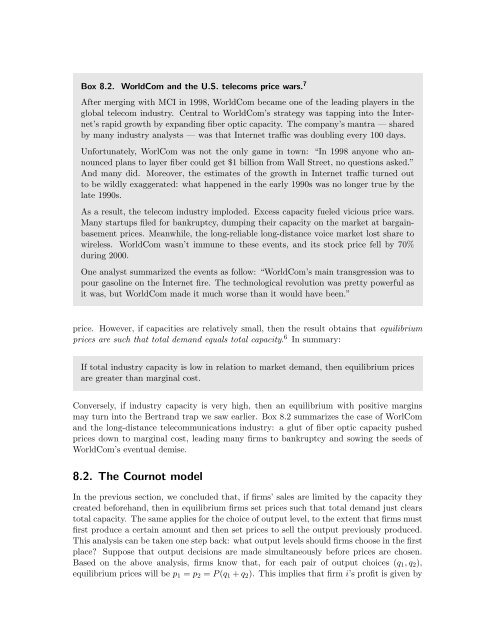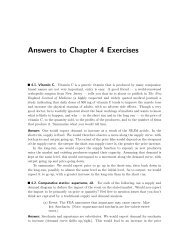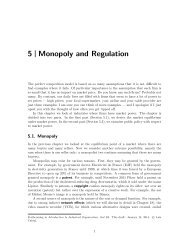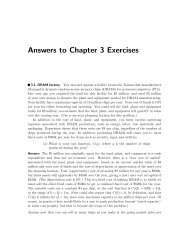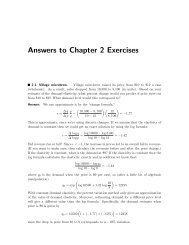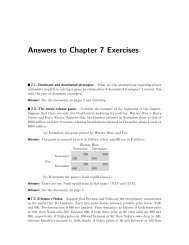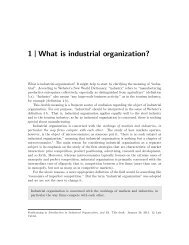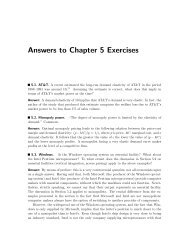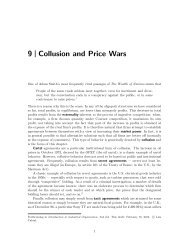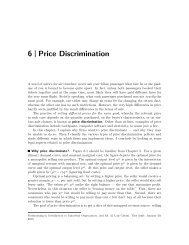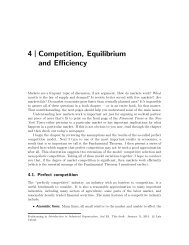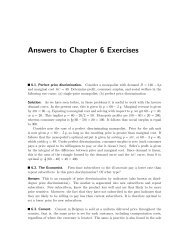8 Oligopoly - Luiscabral.net
8 Oligopoly - Luiscabral.net
8 Oligopoly - Luiscabral.net
You also want an ePaper? Increase the reach of your titles
YUMPU automatically turns print PDFs into web optimized ePapers that Google loves.
Box 8.2. WorldCom and the U.S. telecoms price wars. 7<br />
After merging with MCI in 1998, WorldCom became one of the leading players in the<br />
global telecom industry. Central to WorldCom’s strategy was tapping into the Inter<strong>net</strong>’s<br />
rapid growth by expanding fiber optic capacity. The company’s mantra — shared<br />
by many industry analysts — was that Inter<strong>net</strong> traffic was doubling every 100 days.<br />
Unfortunately, WorlCom was not the only game in town: “In 1998 anyone who announced<br />
plans to layer fiber could get $1 billion from Wall Street, no questions asked.”<br />
And many did. Moreover, the estimates of the growth in Inter<strong>net</strong> traffic turned out<br />
to be wildly exaggerated: what happened in the early 1990s was no longer true by the<br />
late 1990s.<br />
As a result, the telecom industry imploded. Excess capacity fueled vicious price wars.<br />
Many startups filed for bankruptcy, dumping their capacity on the market at bargainbasement<br />
prices. Meanwhile, the long-reliable long-distance voice market lost share to<br />
wireless. WorldCom wasn’t immune to these events, and its stock price fell by 70%<br />
during 2000.<br />
One analyst summarized the events as follow: “WorldCom’s main transgression was to<br />
pour gasoline on the Inter<strong>net</strong> fire. The technological revolution was pretty powerful as<br />
it was, but WorldCom made it much worse than it would have been.”<br />
price. However, if capacities are relatively small, then the result obtains that equilibrium<br />
prices are such that total demand equals total capacity. 6 In summary:<br />
If total industry capacity is low in relation to market demand, then equilibrium prices<br />
are greater than marginal cost.<br />
Conversely, if industry capacity is very high, then an equilibrium with positive margins<br />
may turn into the Bertrand trap we saw earlier. Box 8.2 summarizes the case of WorlCom<br />
and the long-distance telecommunications industry: a glut of fiber optic capacity pushed<br />
prices down to marginal cost, leading many firms to bankruptcy and sowing the seeds of<br />
WorldCom’s eventual demise.<br />
8.2. The Cournot model<br />
In the previous section, we concluded that, if firms’ sales are limited by the capacity they<br />
created beforehand, then in equilibrium firms set prices such that total demand just clears<br />
total capacity. The same applies for the choice of output level, to the extent that firms must<br />
first produce a certain amount and then set prices to sell the output previously produced.<br />
This analysis can be taken one step back: what output levels should firms choose in the first<br />
place? Suppose that output decisions are made simultaneously before prices are chosen.<br />
Based on the above analysis, firms know that, for each pair of output choices (q 1 , q 2 ),<br />
equilibrium prices will be p 1 = p 2 = P (q 1 + q 2 ). This implies that firm i’s profit is given by


